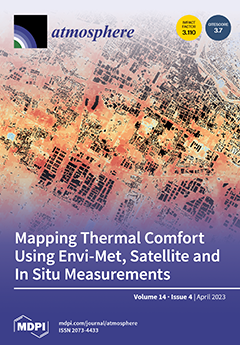The concentrations of trace elements in atmospheric bulk depositions (wet plus dry) were investigated from two highly industrialised areas of Sicily (southern Italy) from June 2018 to July 2019, in order to recognise the main natural and anthropogenic sources. A side objective of this study was to improve the common sampling procedures and analytical methods used for monitoring trace elements in atmospheric deposition. The trace element VWM (Volume-Weighted Mean) concentrations ranged from less than 0.01 μg L
−1 for trace elements such as Cs, Tl, and U, up to 24 μg L
−1 for minor elements (Al, Zn, Sr), in the filtered aliquot, while they reached concentrations up to 144 μg L
−1 for the same elements, in the unfiltered aliquot. Therefore, significant differences in concentrations between these two aliquots were found, particularly for Al, Fe, Ti, Zn, Cr, Pb, Se, Cs, and U. This implies that filtering operations may produce a consistent underestimation of concentrations of certain ‘constituents’ of the atmospheric deposition. Natural (marine spray, local and regional geogenic input, volcanic emanations) and anthropogenic sources (industrial emissions, auto vehicular traffic, and diffuse background pollution) which influence rainwater chemistry were identified. Enrichment factors (EFs), with respect to the upper crust composition, provided clear evidence of the different sources above mentioned: Ti, Fe, Al, Cs, Cr, Rb, and Co have low EFs (<1), and are referable to the (local and/or regional) geogenic input, while Se, Sb, Zn, B, Cd, Cu, Mo, Sr, As, with high EFs (>10), highlight the influence of marine and/or industrial sources. The study produced a novel dataset on the atmospheric deposition rate of several trace elements, which had never been studied in the investigated areas. Finally, a comparison of trace element deposition rates in the studied areas with the atmospheric deposition reported for 53 different sites, belonging to 20 different European nations, was made. The comparison showed that some elements, such as Al, V, Zn, and Mo had higher median deposition fluxes in the Sicilian sites than in European monitoring sites.
Full article





